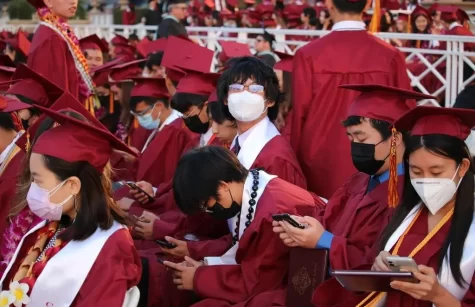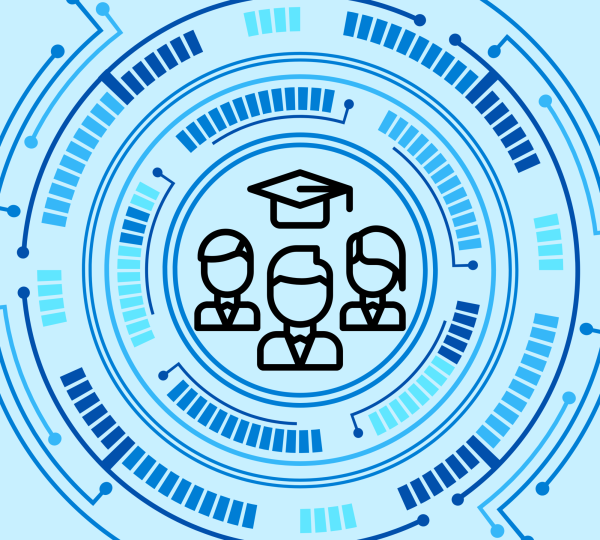Technology’s Impacts on Students
As the digital age progresses and becomes increasingly integrated into our lives, school systems and students are trying to navigate technology in education. In recent years school systems have integrated technology into their curriculum with mixed results.
When the pandemic hit in 2019, teachers and students adjusted rapidly to an online school system that lasted for two years. When schools transitioned back to in-person learning, many of the technological adaptations carried over. In the past four years, students’ daily screen time has tripled, and negative impacts increased alongside it, according to a study by the National Institutes of Health.
Kids’ attention and learning abilities are decreasing due to the amount of technology frequently at their fingertips. School is supposed to be a safe learning environment that promotes thoughtful, insightful, and profound thinking and conversations. These conversations and thoughts are cut off and prevented from occurring by way of technology. “Students exist in a bubble, never taking social risks,” Mr. James Rogulski, an English teacher at Hendrick Hudson, observes, “students hide in their phones, not socializing– their true reality is now in the digital realm.”

Technology in schools has brought on more than just engagement issues. In a study conducted by Microsoft, the average attention span of teens and young adults in the year 2000 was 12 seconds. In 2016, the time was reduced to eight seconds, lower than a goldfish’s. The bombardment of images and information from the internet and social media has particularly contributed to this. Making technology so easily accessible to students is only worsening this effect.
In a school day, students should be able to make their way through their classes learning what is being taught to them, period by period; instead, on top of the information they are getting through their classes, they are receiving a constant influx of distractions from their handheld digital universe. The torpedo of emails filled with news, advertisements, college information, and beyond fill a student’s mind with a myriad of other topics, good and bad, drawing their attention away from the task at hand.
A study created by the George Lucas Educational Foundation has linked teens’ distracted phone use to lower, failing grades. With 54 percent of students using their phones in class, the inability to focus on one task harms retention or information recall later for tests. With the inclusion of technology and the rise of the digital revolution has also come a rise in dropout rates and negative academic performance.
This issue has not only presented itself as a decrease in attention span but also in a decrease in quality of work. Students can sometimes find themselves rushing to meet their deadlines because the internet distracted them when they attempted to get it done in the days prior. Even when they crunch down to meet their deadline, their phones, TVs, and computers constantly act as distractions that grab and pull their attention everywhere but what they are trying to complete; as they reel their focus back in, they find that they lose their train of thought, or flow, that kept the work going before, making it even harder to complete now. The inclusion of technology in school systems aids in this effect: if a student’s learning environment constantly involves the inclusion of technology, why would they do anything different at home?
The internet provides countless resources and can help students and teachers deepen their understanding of something or enable them to learn more about a topic. This also presents a problem, as in recent years plagiarism as a result of the internet has increased. Instead of using the internet as a positive source, students are directly paraphrasing or copying the information they find without citation, leaving little to no room for further learning and understanding and inducing an illegal act.
Trip Gabriel, a reporter for the New York Times, spoke to several educators and students at colleges across the US about plagiarism. His findings suggest that students who have (and have mostly always had) easy and accessible internet access may not take plagiarism as seriously as those before them. As Turnitin.com, a submission website that detects plagiarism in papers, claims, “today’s digital culture has blurred the lines of originality and authorship.”
Alternatively, note-taking on paper has also proven to help students retain greater amounts of information. According to research by Ibanez, several studies show that although computers allow for quicker note-taking, handwriting notes improve students’ recognition and retention of information. Moreover, reading and writing on physical paper improve conceptual understanding.
Physical health is also impacted by technology. A vision study by the National Eye Institute proved that over time, consistent exposure to blue light radiation (the light emitted from most digital screens) can cause or contribute to damage to the retinal cells, vision problems such as age-related macular degeneration, cataracts, eye cancer, and growths on the clear covering over the white part of the eye. The study also showed that children are more at risk of damage caused by blue light because their eyes tend to absorb more of it. Moreover, researcher Strom indicated that the rise of technology has also led to an increase in obesity and a decrease in aerobic fitness. It is recommended that children spend less than two hours of screen time per day, but that time is easily exceeded with schoolwork alone, without even considering personal digital usage.
As a student growing up in an overwhelmingly digital environment, I am constantly facing the issues technology has aroused, specifically within my education. As I write this, the paper is riddled with hypocrisy, as many of the issues I critique I partake in on a daily basis. That being said, students need a clear, concise separation from the digital realm when they enter an educational environment. I speak strongly on the damage that electronic devices create, yet I find myself checking my phone every few minutes in class: why is this? Because nothing is stopping me. Growing up with technology has affected my ability to enact self-control. To battle this phenomenon, clear and firm parameters must be implemented; this will encourage the most successful and effective learning and reverse the damage that the digital world has produced in students. The solution is not to abolish technology entirely but to integrate it more appropriately.

Cell phone use should be limited in educational environments for teachers and students. The use of technology to teach should be limited, and instruction should be provided to teachers who choose to use it to become savvy and avoid excessive stress. Schools should not strive to keep up with the latest technological advances and instead spend the time and money to improve school programs, materials, and student learning assistance. Students should be held to high expectations for the quality of their work instead of digital completion. Once students begin reaching the expectations, not only will their work improve, but their overall satisfaction, motivation, and courage will as well.
The digital age we are growing up in is destroying the quality of education and our future. We must fight to resist the overtaking of technology and integrate it in more positive ways than have been tried before. The journey to understanding technology has been a long, hard one, and it is far from over; however, with the information we have now, schools have the opportunity to reverse the damage inflicted by the digital revolution, and the change starts when we do.
Your donation will promote student journalism at Hen Hud.

Hayden is editor-in-chief of The Anchor and a Senior at Hendrick Hudson High School. Outside of the newspaper, Hayden enjoys reading (especially classics),...










